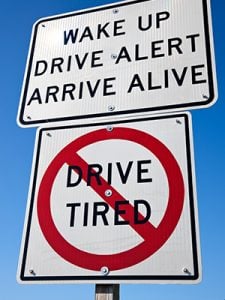You Snooze, You Lose. Don't Drive Drowsy!
This week's safety bulletin discusses the importance of staying alert while driving. Read the full safety bulletin here and subscribe to receive future safety bulletins straight to your mailbox.
November 5 through 11, 2023, is Drowsy Driving Prevention Week.
The National Sleep Foundation has launched Drowsy Driving Prevention Week as an educational campaign designed to save lives by increasing awareness of the dangers of driving while sleepy. The National Highway Traffic Safety Administration estimates that drowsy driving causes at least 100,000 police-reported crashes and kills more than 1,550 Americans each year. All states have laws in place to enforce drunken driving, but few have laws to cite a driver who has fallen asleep, causing an accident. Only the state of New Jersey explicitly defines drowsy driving as recklessness under a vehicular homicide statute. Known as "Maggie's Law," New Jersey's drowsy driving law has raised awareness of the consequences of fatigue behind the wheel and has spurred significant action in other states. There are now at least eight states with 12 pending bills that address fatigued driving in various ways.
For more information on Drowsy Driving Prevention Week, click here

What You Can Do to Stay Alert While Driving
Sleep / Take naps: Your best bet is to get enough sleep daily. If you must stay up late, afternoon naps are a great way to get more sleep. If you feel drowsy while driving, a 15-minute nap can be very effective. Make sure to pull over in a safe place.
Caffeine: Avoid caffeine during the last half of your workday, as it may contribute to sleeping problems. You can gain short-term alertness by drinking coffee or other caffeine sources if driving, but it usually takes 30 minutes to take effect and wears off after a few hours.
Regular stops: You should stop every 100 miles or 2 hours. Switch drivers if you can.
AC MAX – Recirculation: Do not operate the vehicle for extended periods with the AC on MAX or Recirculation. Under these conditions, the level of C02 in the vehicle increases, contributing to drowsy driving.
Avoid Alcohol: If you have been drinking, please don't drive! In addition to being illegal, alcohol makes you sleepy and amplifies your fatigue.
If you are planning a long trip, AAA offers the following tips for avoiding fatigue:
- Prepare for your trip by getting a good night's sleep the night before. Plan to drive when you are generally awake and stay overnight rather than traveling straight through.
- Avoid driving during the body's "downtime." According to AAA, this is generally mid-afternoon and between midnight and 6:00 a.m.
- If you have passengers, talk to them. It will help to keep you alert, and they will also be able to tell if you are showing signs of getting sleepy.
- Schedule a break every 2 hours or every 100 miles. Take a nap, stretch, take a walk, and get some exercise before resuming your trip.
- Stop sooner if you show any dangerous signs of sleepiness.
"TRICKS" THAT DO NOT WORK
Opening the window, turning on the air conditioning, or playing loud music is ineffective in keeping drivers alert for an extended period.
Halloween Driving “Tricks” to Keep Everyone Safe

To help everyone bring home treats — not tragedies — follow these tips for a safe Halloween:
- Focus on your driving. A single distraction could lead to a tragedy.
- Stay well below the posted speed limit.
- Pay attention to what's happening on sidewalks and roadways. Watch for children darting across streets, especially between parked cars.
- Be extra alert when pulling in and out of driveways.
- Do not assume children can see you or are paying attention. You need to take that responsibility.
- Drivers should also check that all lights on their vehicle work.
- Do not pass other vehicles that have stopped in the roadway. They could be dropping off children.
- And if you're driving to a Halloween party, put that mask on after you park the car.
Parents can help motorists, too:
- Make sure drivers can see the children. Give them flashlights and glow sticks. Dress kids in bright, reflective clothing or use reflective tape on their costumes
- Use makeup rather than masks, so children have a clear, unobstructed view of their surroundings
- Be sure children know how to cross a street -- look left, right, and left again before crossing
- Instruct children to stay on sidewalks and to cross only at corners or crosswalks
- Accompany your children as they trick or treat
Safely getting in or out of a Commercial Motor Vehicle… 3 Point Rule
Now is an excellent time to remind drivers to follow the 3-point rule while getting in and out of their trucks. During the winter months, footing conditions are compromised, increasing the chance of slipping or falling. The 3-point rule is keeping three out of four of your contact points (hands and feet) secured to keep from slipping or falling. When exiting a truck, for example, one hand on the cab handle, one hand gripping the interior door handle, and one foot on a step while the other foot is in transition; by doing this, you always maintain three points of contact.
CVSA Releases Results of Operation Safe Driver Week
The Commercial Vehicle Safety Alliance has released the results of its Operation Safe Driver Week traffic-enforcement and safe-driving awareness and educational initiative held July 10 to 16, 2023.
State and provincial officers in the U.S. and Canada issued 4,494 tickets/citations and 5,756 warnings to drivers – commercial motor vehicle and passenger vehicle drivers combined.
A total of 4,592 warnings and 2,634 tickets/citations were given to commercial motor vehicle drivers, and officers issued 1,164 warnings and 1,860 tickets/citations to passenger vehicle drivers.
Speeding, the focus area for this year's Operation Safe Driver Week, was a top infraction for commercial and passenger vehicle drivers. Commercial motor vehicle drivers received 1,575 warnings and 715 tickets/citations, and passenger vehicle drivers received 625 warnings and 1,293 citations/tickets for speed-related infractions. Combined, 2,219 warnings and 2,024 citations/tickets were issued for speeding.
CVSA asserts that speeding accounts for nearly one-third of all fatalities on roadways. According to the National Highway Traffic Safety Administration, speeding-related fatalities increased 8% from 2020 to 2021, with 12,330 people killed in 2021 in speeding-related crashes, representing 29% of all traffic fatalities in 2021. Additionally, Transport Canada states that speeding/driving too fast accounted for 25.3% of all fatal roadway crashes in Canada in 2020.

Atlanta Idealease to Hold an Open House and Debut the New Navistar eMV Battery Electric Medium Duty Truck!
If you are interested in attending and test driving this eMV, contact Atlanta Idealease at 770-590-5109

Time to Fall Back…..Daylight Savings Time Changes on November 5th!
Daylight savings time will "fall back" at 2:00 a.m. on Sunday, November 5th. Make sure that all your drivers are aware that the change to daylight savings will occur. Caution route drivers that the amount of daylight will change according to their stops with the change. An intersection or street can present different challenges to drivers with an hour change in the sun's position. One hour of time difference can present unique adaptations to a driver on a route.

Question of the Week
Q: May motor carriers report the results of drug or alcohol tests NOT required by the Department of Transportation (DOT) to the Drug and Alcohol Clearinghouse
A: No. Only results of DOT drug or alcohol tests or refusals may be reported to the Clearinghouse. While employers may conduct drug and alcohol testing that is outside the scope of the DOT testing requirements, positive test results or refusals for non-DOT testing may not be reported to the Clearinghouse.
*The Idealease Safety Bulletin is provided for Idealease locations and their customers and is not to be construed as a complete or exhaustive source of compliance or safety information. The Idealease Safety Bulletin is advisory in nature and does not warrant, guarantee, or otherwise certify compliance with laws, regulations, requirements, or guidelines of any local, state, or Federal agency and/or governing body, or industry standard.
